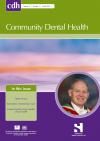Community Dental Health

- Cover Date:
- March 2015
- Print ISSN:
- 0265 539X
- Vol:
- 32
- Issue:
- 1
Health economic analyses of domiciliary dental care and care at fixed clinics for elderly nursing home residents in Sweden
© BASCD 2015 doi:10.1922/CDH_3407Lundqvist05
Health economic analyses of domiciliary dental care and care at fixed clinics for elderly nursing home residents in Sweden
M. Lundqvist, T. Davidson, S. Ordell, O. Sjöström, M. Zimmerman and P. Sjögren
Objectives: Dental care for elderly nursing home residents is traditionally provided at fixed dental clinics, but domiciliary dental care is an emerging alternative. Longer life expectancy accompanied with increased morbidity, and hospitalisation or dependence on the care of others will contribute to a risk for rapid deterioration of oral health so alternative methods for delivering oral health care to vulnerable individuals for whom access to fixed dental clinics is an obstacle should be considered. The aim was to analyse health economic consequences of domiciliary dental care for elderly nursing home residents in Sweden, compared to dentistry at a fixed clinic. Methods: A review of relevant literature was undertaken complemented by interviews with nursing home staff, officials at county councils, and academic experts in geriatric dentistry. Domiciliary dental care and fixed clinic care were compared in cost analyses and cost-effectiveness analyses. Results: The mean societal cost of domiciliary dental care for elderly nursing home residents was lower than dental care at a fixed clinic, and it was also considered cost-effective. Lower cost of dental care at a fixed dental clinic was only achieved in a scenario where dental care could not be completed in a domiciliary setting. Conclusions: Domiciliary dental care for elderly nursing home residents has a lower societal cost and is cost-effective compared to dental care at fixed clinics. To meet current and predicted need for oral health care in the ageing population alternative methods to deliver dental care should be available.
Key words: aged, dentistry, domiciliary care, geriatric dentistry, health care economics and organizations, home care services, nursing homes, Sweden
- Article Price
- £15.00
- Institution Article Price
- £
- Page Start
- 39
- Page End
- 43
- Authors
- M. Lundqvist, T. Davidson, S. Ordell, O. Sjöström, M. Zimmerman, P. Sjögren
Articles from this issue
- Title
- Pg. Start
- Pg. End
- Comparing lifecourse models of social class and adult oral health using the 1958 National Child Development Study
- 20
- 25
- Barriers to providing oral health care to pre-school children– differences between paediatric dentists’ and general dental practitioners’ beliefs
- 32
- 38
- Health economic analyses of domiciliary dental care and care at fixed clinics for elderly nursing home residents in Sweden
- 39
- 43
- Tooth brushing among 11- to 15-year-olds in Denmark: combined effect of social class and migration status.
- 51
- 55
- The incidence and nature of complaints against dentists for the treatment of children in Israel from 1992–2011
- 56
- 59
